One of the oldest Greek legends refers to the mysterious destruction of the "Lost Continent of Altantis." According to this legend, which the famous Greek philosopher Plato wrote about in The Republic, the whole continent was destroyed and sunk beneath the sea. For years the story of Atlantis was considered just a myth, but some archaeologists and historians now think they have found the source of the Altantis legend on a Greek island called Santorini, named after the volcano which is located on the island. We know around 1500 BC a mighty eruption of the Santorini Volcano occurred that destroyed much of the island. Before the eruption the island had been over 1800 meters high, but after the eruption the island collapsed onto itself forming a giant C-shaped caldera. A Minoan settlement called Akroteri had been located on what is now the rim of the resulting caldera. Akroteri was completely covered by volcanic materials during the eruption, but today is slowly providing a wonderful glimpse into the life of the ancient culture that existed there.
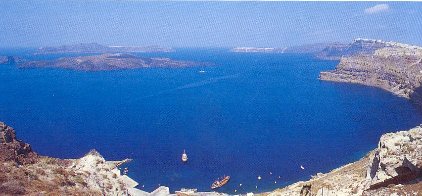 The caldera of Santorini today |
The ancient city which is now being revealed was covered beneath a thick layer of pumice and ash and has thus been preserved for us to uncover today. Although only about 1/30th of the city has been uncovered so far, it has already provided us an incredible storehouse of ancient art and artifacts.
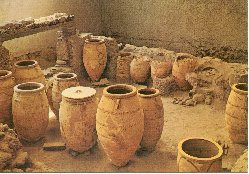 Hundreds of storage pots remain |
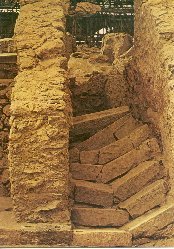 Twisted Stairs caused by the eruption |
Narrow cobbled streets traversed Akroteri which here and there widened to form squares. Even with the tin roofs that cover and protect the site, when one walks through the streets and is surrounded by the ruins of buildings it is very easy to imagine being back in ancient Akroteri.
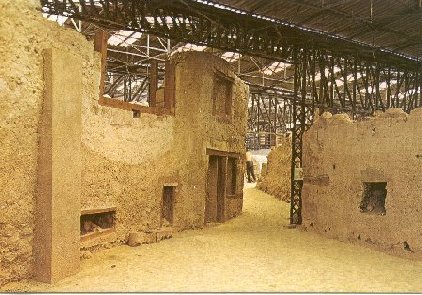 An Akroteri street and square |
Two and three storied houses and shops lined either side of the streets, with walls built of stone and mortar. Under the paving of the streets waste water was conveyed into sewers, and other clay pipes acted as storm drains. Stone walled buildings were reinfoced by wooden beams and joists to protect them from seismic disturbances.
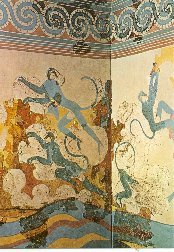 Room of the Blue Monkeys |
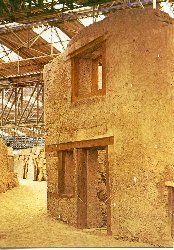 Exterior of two stored building |
The Akroteri excavation has given us a host of wall-paintings in a remarkably good state of preservation. There is hardly a house without at least one room decorated with wall paintings.
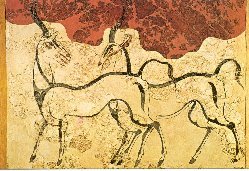 Antelopes adorn walls |
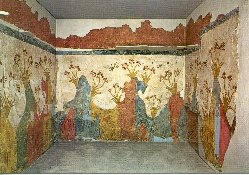 Interior of Room with frescos |
On the smoothed plaster on the insides walls of the houses frescos depict landscapes, geometric designs, animals, and scenes of everyday life in bright colors. We learn of the jewellery and clothing they wore, what hairstyles men and women favored, armour and weapons they used, what sports they liked, and their ship building and sailing from these paintings.
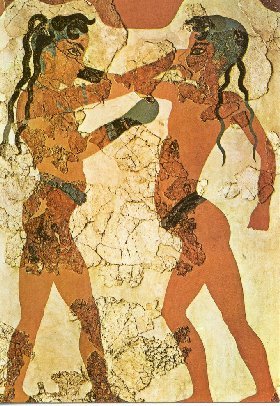 The Boxers fresco |
Was Santorini the lost continent of Altantis? We know that Santorini has had many names in the past like "Thera," "Therasia," and "Strongyle." Asia is a continent today, and "Terra" now means "earth." Lastly, Strongyle means "round-one" and Plato describe Atlantis as a round continent in the shape of a circle with water inside, just like the island of Santorini. Did this island become the continent of Altantis in legend, and did it's destruction start the legend of Altantis?
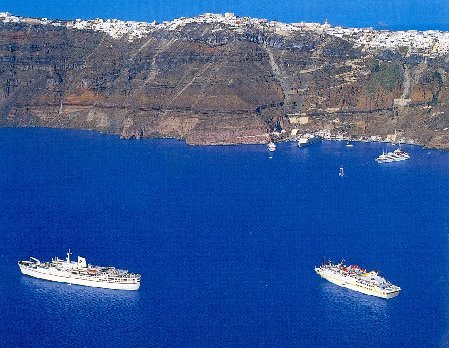 Is this Altantis? |
| sources: |
"Ancient Thera" on Odysseus (Hellenic Ministry of Culture) at: http://http://www.culture.gr/2/21/211/21121a/e211ua05.html |
| anonymous. Getting to know Santorini. Athens: Hattalis Editions, 1998 | |
| Doumas, Christos G. Santorini. Athens: Hannibal Publishing House, 1957. | |
| "Pictures of Santorini by Hans van Reenen" at: http://baserv.uci.kun.nl/~hvreenen/santorini/santorini.htm | |
| "Santorini" at: http://www.thiraweb.com | |
| Tour guide at Akroteri - July 16. 1999. |